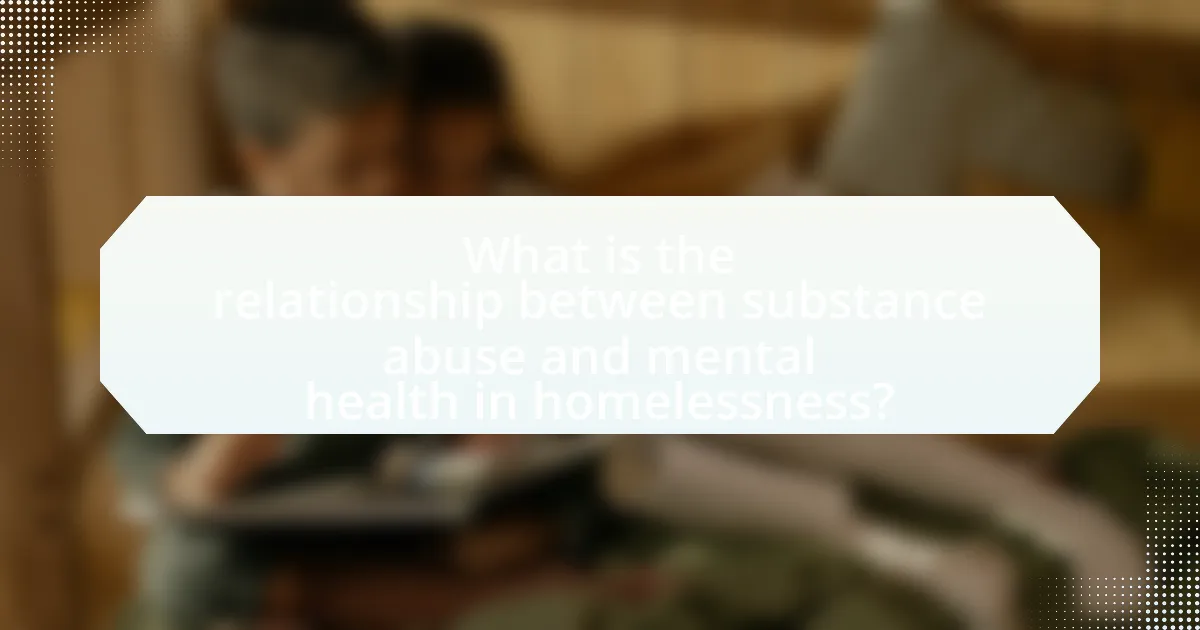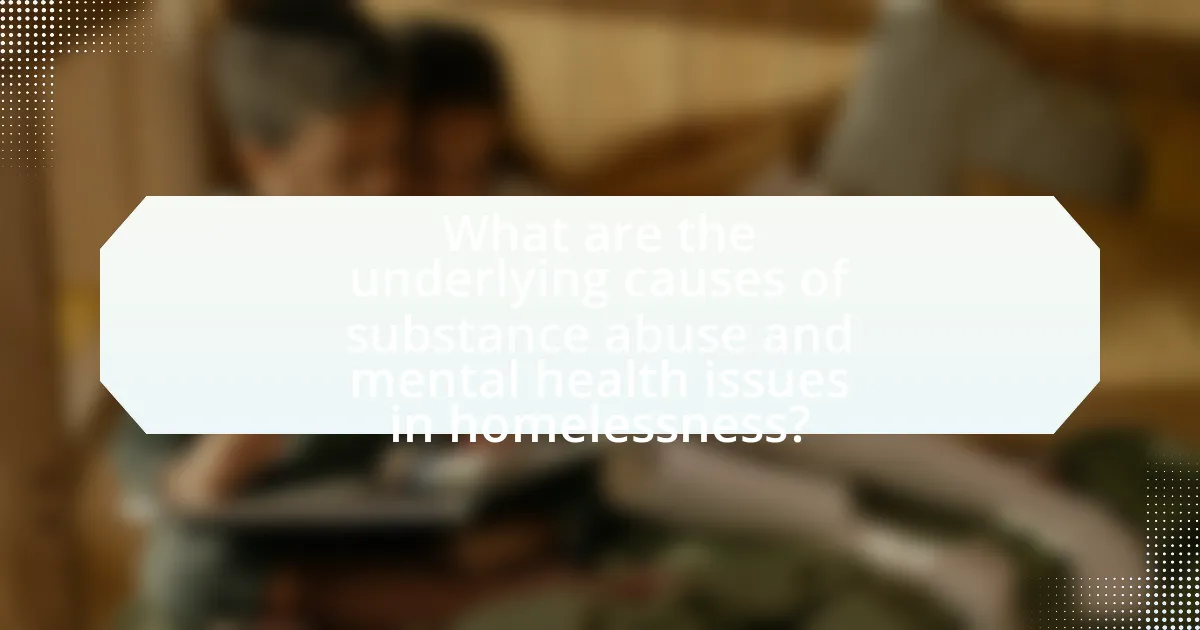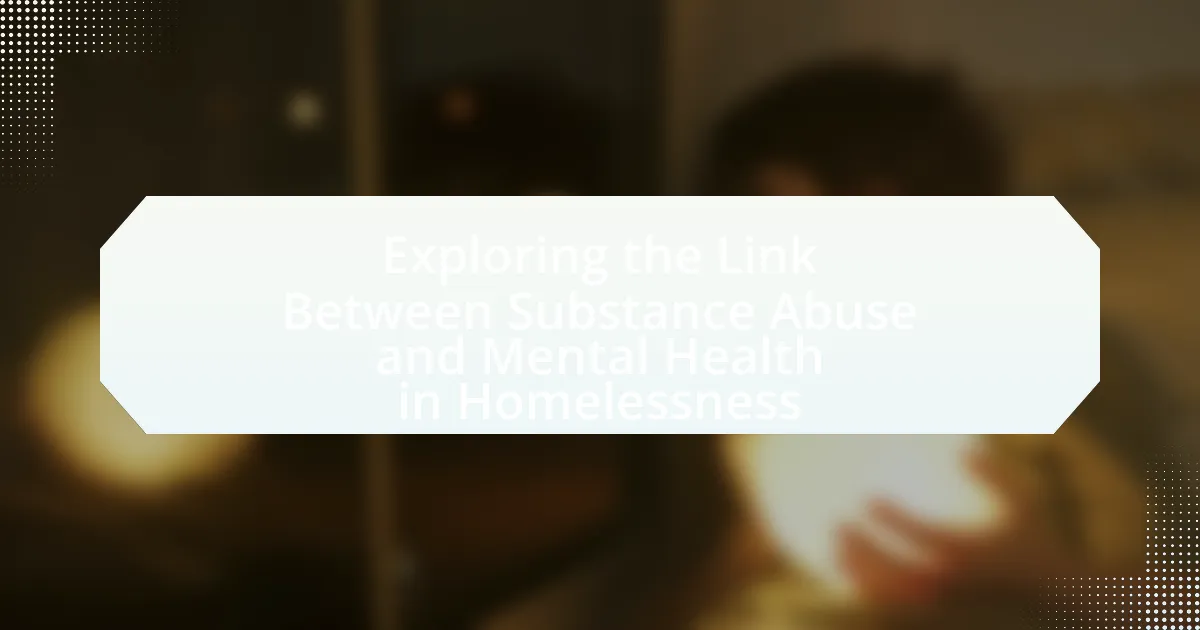The article explores the intricate relationship between substance abuse and mental health issues within the homeless population. It highlights how these two conditions often coexist, with approximately 30% of homeless individuals suffering from substance use disorders and around 20% experiencing severe mental illness. The cyclical nature of this relationship complicates treatment and recovery, as untreated mental health issues can lead to substance abuse and vice versa. The article emphasizes the importance of integrated treatment approaches that address both substance abuse and mental health simultaneously to improve outcomes for homeless individuals and reduce homelessness rates. Additionally, it discusses the underlying causes, social factors, and effective interventions that can enhance recovery and stability for this vulnerable population.

What is the relationship between substance abuse and mental health in homelessness?
Substance abuse and mental health are closely intertwined in the context of homelessness, with each condition exacerbating the other. Individuals experiencing homelessness often face high levels of stress, trauma, and social isolation, which can lead to mental health disorders such as depression and anxiety. Concurrently, those with mental health issues may turn to substances as a coping mechanism, leading to substance abuse. Research indicates that approximately 30% of homeless individuals have a substance use disorder, while around 20% experience severe mental illness, highlighting the prevalence of co-occurring disorders in this population. This cyclical relationship creates significant barriers to recovery and stable housing, as untreated mental health issues can hinder the ability to seek help for substance abuse, and vice versa.
How do substance abuse and mental health issues intersect among the homeless population?
Substance abuse and mental health issues intersect among the homeless population primarily through a cycle of co-occurrence, where each condition exacerbates the other. Research indicates that approximately 30% of homeless individuals suffer from mental health disorders, while around 50% struggle with substance use disorders. This dual diagnosis complicates treatment, as mental health issues can lead to substance use as a coping mechanism, and substance abuse can worsen mental health conditions. For instance, a study published in the American Journal of Psychiatry found that individuals with severe mental illness are more likely to engage in substance use, which in turn can lead to increased rates of homelessness. This interrelationship highlights the need for integrated treatment approaches that address both substance abuse and mental health simultaneously to effectively support the homeless population.
What are the common mental health disorders found in homeless individuals with substance abuse issues?
Common mental health disorders found in homeless individuals with substance abuse issues include depression, anxiety disorders, post-traumatic stress disorder (PTSD), and schizophrenia. Research indicates that approximately 30% of homeless individuals experience severe mental illness, with a significant overlap between mental health disorders and substance use disorders. For instance, a study published in the American Journal of Psychiatry found that individuals with co-occurring disorders often face higher rates of homelessness, highlighting the critical need for integrated treatment approaches.
How does substance abuse exacerbate existing mental health conditions in the homeless?
Substance abuse significantly worsens existing mental health conditions in the homeless by creating a cycle of dependency and exacerbating symptoms. For instance, individuals with pre-existing mental health disorders, such as depression or anxiety, may turn to drugs or alcohol as a form of self-medication, which can lead to increased severity of their symptoms. Research indicates that substance use can alter brain chemistry, making it more difficult for individuals to manage their mental health effectively. According to the National Coalition for the Homeless, approximately 30% of homeless individuals have a mental health condition, and substance abuse is prevalent among this population, further complicating treatment and recovery efforts. This interplay between substance abuse and mental health issues creates barriers to accessing necessary care, leading to a worsening of both conditions.
Why is understanding this link important for addressing homelessness?
Understanding the link between substance abuse and mental health is crucial for addressing homelessness because it directly influences the effectiveness of intervention strategies. Research indicates that approximately 30% of homeless individuals struggle with substance use disorders, while around 20% experience severe mental illness, highlighting the intertwined nature of these issues. Addressing both substance abuse and mental health simultaneously can lead to more comprehensive treatment plans, ultimately reducing the risk of homelessness and improving long-term outcomes for affected individuals.
What impact does the link between substance abuse and mental health have on homelessness rates?
The link between substance abuse and mental health significantly increases homelessness rates. Individuals suffering from mental health disorders often turn to substance abuse as a coping mechanism, which exacerbates their instability and reduces their ability to maintain housing. Research indicates that approximately 30% of the homeless population in the United States has a serious mental illness, and around 50% struggle with substance abuse issues, according to the Substance Abuse and Mental Health Services Administration (SAMHSA). This dual diagnosis creates a cycle where mental health challenges lead to substance use, which in turn contributes to homelessness, making it difficult for affected individuals to access stable housing and support services.
How can addressing these issues improve outcomes for homeless individuals?
Addressing substance abuse and mental health issues can significantly improve outcomes for homeless individuals by facilitating access to necessary treatment and support services. When these issues are effectively managed, individuals are more likely to secure stable housing, maintain employment, and improve their overall well-being. Research indicates that integrated treatment programs, which address both mental health and substance use disorders simultaneously, can lead to a 50% reduction in homelessness among participants, as shown in studies conducted by the Substance Abuse and Mental Health Services Administration. By providing comprehensive care, homeless individuals can achieve greater stability and reintegration into society.

What are the underlying causes of substance abuse and mental health issues in homelessness?
The underlying causes of substance abuse and mental health issues in homelessness include trauma, lack of access to healthcare, and social isolation. Trauma, often stemming from experiences such as violence, abuse, or loss, can lead individuals to self-medicate with substances, exacerbating mental health conditions. Additionally, the lack of access to mental health services and substance abuse treatment creates a cycle where individuals cannot receive the help they need, further entrenching their homelessness. Social isolation, which is prevalent among homeless populations, can lead to feelings of despair and hopelessness, contributing to both substance abuse and mental health deterioration. Studies indicate that approximately 30% of homeless individuals suffer from mental health disorders, and many turn to drugs or alcohol as a coping mechanism, highlighting the interconnectedness of these issues.
What social factors contribute to substance abuse and mental health challenges in the homeless?
Social factors such as poverty, social isolation, and lack of access to healthcare significantly contribute to substance abuse and mental health challenges in the homeless population. Poverty creates a cycle of stress and desperation, leading individuals to use substances as a coping mechanism. Social isolation exacerbates feelings of loneliness and depression, which can drive individuals toward substance use as a form of escape. Additionally, the lack of access to healthcare services prevents homeless individuals from receiving necessary mental health support and substance abuse treatment, further worsening their conditions. Studies indicate that approximately 25% of homeless individuals suffer from severe mental illness, and many also struggle with substance use disorders, highlighting the interconnectedness of these social factors.
How do poverty and lack of access to healthcare influence these issues?
Poverty and lack of access to healthcare significantly exacerbate substance abuse and mental health issues among the homeless population. Individuals living in poverty often experience chronic stress, which can lead to mental health disorders, while inadequate access to healthcare prevents them from receiving necessary treatment for these conditions. According to the National Coalition for the Homeless, approximately 25% of homeless individuals suffer from severe mental illness, and many do not receive adequate care due to financial constraints and lack of insurance. This lack of treatment can lead to increased substance abuse as individuals may turn to drugs or alcohol as a coping mechanism for their untreated mental health issues.
What role does trauma play in the lives of homeless individuals struggling with substance abuse?
Trauma significantly impacts the lives of homeless individuals struggling with substance abuse by often serving as both a precursor and a perpetuating factor of their addiction. Many homeless individuals have experienced severe trauma, including physical or sexual abuse, domestic violence, or the loss of loved ones, which can lead to mental health issues such as depression and anxiety. Research indicates that approximately 70% of homeless individuals report a history of trauma, which correlates with higher rates of substance use as a coping mechanism. This cycle of trauma and substance abuse creates a barrier to recovery, as the underlying psychological issues remain unaddressed, further entrenching individuals in homelessness and addiction.
How do systemic issues affect the link between substance abuse and mental health in homelessness?
Systemic issues significantly exacerbate the connection between substance abuse and mental health challenges in homelessness. Factors such as poverty, lack of affordable housing, inadequate access to healthcare, and systemic discrimination create an environment where individuals are more likely to experience both mental health disorders and substance use disorders. For instance, a report from the National Alliance to End Homelessness indicates that individuals facing homelessness often encounter barriers to mental health services, leading to increased reliance on substances as a coping mechanism. Additionally, systemic failures in social support systems can perpetuate cycles of trauma and instability, further entrenching both mental health and substance abuse issues among homeless populations.
What are the barriers to accessing mental health and substance abuse treatment for the homeless?
Barriers to accessing mental health and substance abuse treatment for the homeless include lack of affordable housing, stigma, and inadequate healthcare resources. The absence of stable housing often exacerbates mental health issues and substance use, making it difficult for individuals to seek and maintain treatment. Stigma surrounding mental health and addiction can deter homeless individuals from seeking help due to fear of judgment or discrimination. Additionally, many healthcare systems lack the resources or programs specifically tailored to address the unique needs of the homeless population, resulting in insufficient access to necessary services. According to the National Alliance to End Homelessness, approximately 25% of homeless individuals experience severe mental illness, yet only a fraction receive appropriate treatment due to these barriers.
How do societal stigmas impact the willingness of homeless individuals to seek help?
Societal stigmas significantly reduce the willingness of homeless individuals to seek help. These stigmas often lead to feelings of shame and isolation, causing individuals to avoid services that could assist them. Research indicates that 70% of homeless individuals report experiencing stigma, which correlates with lower rates of service utilization. The fear of being judged or discriminated against discourages them from accessing necessary resources, such as mental health care and substance abuse treatment. Consequently, societal attitudes directly influence the likelihood of homeless individuals reaching out for support, perpetuating a cycle of neglect and worsening conditions.

What are effective interventions for addressing substance abuse and mental health in the homeless population?
Effective interventions for addressing substance abuse and mental health in the homeless population include integrated treatment programs that combine mental health services with substance use disorder treatment. Research indicates that such integrated approaches lead to better outcomes, as they address the complex interplay between mental health issues and substance abuse. For instance, a study published in the Journal of Substance Abuse Treatment found that individuals receiving integrated care showed significant improvements in both mental health symptoms and substance use compared to those receiving separate treatments. Additionally, harm reduction strategies, such as providing safe consumption spaces and access to naloxone, have proven effective in reducing overdose deaths and promoting safer practices among homeless individuals struggling with addiction. These interventions not only improve individual health outcomes but also contribute to overall community safety and well-being.
What types of treatment programs are available for homeless individuals with substance abuse and mental health issues?
Various treatment programs are available for homeless individuals facing substance abuse and mental health issues, including integrated treatment programs, supportive housing, outpatient services, and detoxification programs. Integrated treatment programs combine mental health and substance abuse services, addressing both issues simultaneously, which has been shown to improve outcomes for individuals with co-occurring disorders. Supportive housing provides stable living environments while offering access to mental health and substance abuse treatment, significantly reducing homelessness and improving recovery rates. Outpatient services allow individuals to receive therapy and counseling while maintaining their daily routines, making it easier for them to engage in treatment. Detoxification programs assist individuals in safely withdrawing from substances, often serving as a critical first step in the recovery process. These programs are supported by research indicating that comprehensive, tailored approaches lead to better long-term recovery outcomes for homeless individuals.
How do integrated treatment models address both substance abuse and mental health simultaneously?
Integrated treatment models address both substance abuse and mental health simultaneously by providing coordinated care that integrates behavioral health services with substance use treatment. These models recognize the interrelated nature of mental health disorders and substance use disorders, allowing for a comprehensive approach that treats both issues concurrently rather than in isolation. Research indicates that individuals with co-occurring disorders benefit from this integrated approach, as it improves treatment outcomes and reduces the likelihood of relapse. For example, a study published in the Journal of Substance Abuse Treatment found that integrated treatment resulted in higher retention rates and better overall functioning compared to traditional sequential treatment methods.
What role do harm reduction strategies play in supporting homeless individuals?
Harm reduction strategies play a crucial role in supporting homeless individuals by minimizing the negative health and social consequences associated with substance use. These strategies, such as needle exchange programs and supervised consumption sites, provide essential services that reduce the risk of overdose, transmission of infectious diseases, and other health complications. For instance, studies have shown that needle exchange programs can lead to a 50% reduction in HIV transmission among people who inject drugs. By addressing immediate health needs and fostering a non-judgmental environment, harm reduction approaches also encourage homeless individuals to engage with healthcare services, ultimately improving their overall well-being and stability.
How can community support systems enhance recovery for homeless individuals?
Community support systems can enhance recovery for homeless individuals by providing essential resources, social connections, and access to mental health and substance abuse treatment. These systems facilitate the integration of services such as housing assistance, counseling, and job training, which are crucial for addressing the complex needs of homeless individuals. Research indicates that programs like the Housing First model, which prioritizes stable housing as a foundation for recovery, significantly improve outcomes for individuals experiencing homelessness, reducing substance use and improving mental health. For instance, a study published in the American Journal of Public Health found that participants in Housing First programs experienced a 50% reduction in substance use and improved mental health outcomes compared to those not in such programs. This evidence underscores the effectiveness of community support systems in fostering recovery among homeless individuals.
What are the best practices for community organizations working with this population?
Community organizations working with the homeless population affected by substance abuse and mental health issues should implement integrated service models that address both mental health and substance use simultaneously. Research indicates that individuals experiencing homelessness often face co-occurring disorders, making it essential for organizations to provide comprehensive care that includes mental health services, substance use treatment, and social support. For instance, the Substance Abuse and Mental Health Services Administration (SAMHSA) emphasizes the importance of a holistic approach, which has been shown to improve outcomes for individuals by reducing barriers to accessing care and fostering recovery. Additionally, establishing strong partnerships with local health services, housing providers, and community resources enhances the effectiveness of interventions, as evidenced by programs that have successfully reduced homelessness rates through coordinated care efforts.
How can peer support programs contribute to recovery and stability?
Peer support programs significantly contribute to recovery and stability by providing individuals with shared experiences and emotional support, which fosters a sense of belonging and understanding. These programs enable participants to connect with peers who have faced similar challenges, promoting hope and motivation for change. Research indicates that individuals engaged in peer support are more likely to adhere to treatment plans and experience reduced symptoms of mental health issues, as evidenced by a study published in the Journal of Substance Abuse Treatment, which found that peer support can lead to a 30% increase in treatment retention rates. Additionally, peer support enhances coping skills and resilience, which are crucial for maintaining stability in recovery from substance abuse and mental health disorders.
What practical steps can be taken to improve outcomes for homeless individuals facing these challenges?
To improve outcomes for homeless individuals facing challenges related to substance abuse and mental health, implementing integrated support services is essential. These services should combine mental health treatment, substance abuse counseling, and housing assistance to address the multifaceted needs of this population. Research indicates that programs offering both mental health and substance use treatment can lead to better recovery outcomes, as evidenced by a study published in the Journal of Substance Abuse Treatment, which found that integrated approaches significantly reduce substance use and improve mental health among homeless individuals. Additionally, providing access to stable housing has been shown to decrease the incidence of substance abuse and improve overall well-being, as highlighted by the National Alliance to End Homelessness, which reports that permanent supportive housing reduces homelessness and improves health outcomes.

Leave a Reply